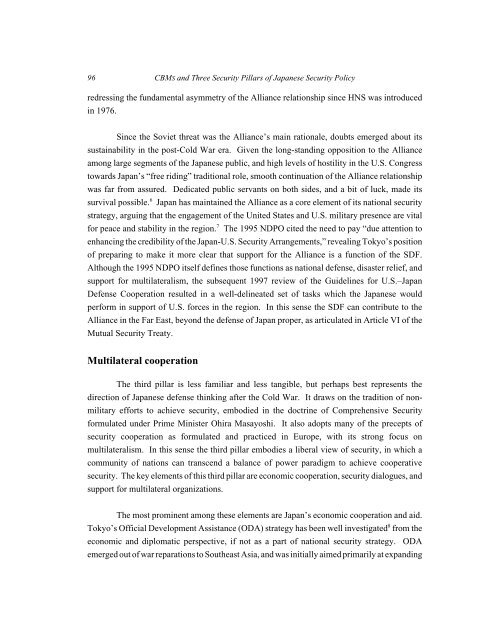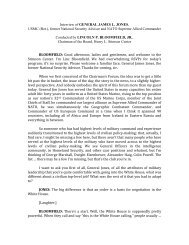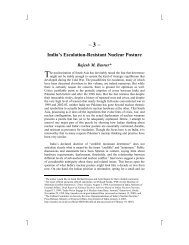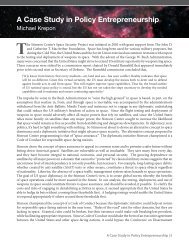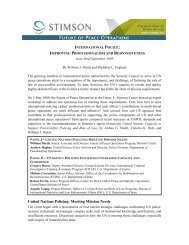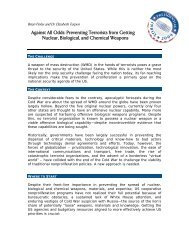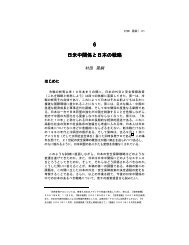CBMs and the Three Pillars of Japanese Security Policy, by ...
CBMs and the Three Pillars of Japanese Security Policy, by ...
CBMs and the Three Pillars of Japanese Security Policy, by ...
Create successful ePaper yourself
Turn your PDF publications into a flip-book with our unique Google optimized e-Paper software.
96<br />
CBMS <strong>and</strong> <strong>Three</strong> <strong>Security</strong> <strong>Pillars</strong> <strong>of</strong> <strong>Japanese</strong> <strong>Security</strong> <strong>Policy</strong><br />
redressing <strong>the</strong> fundamental asymmetry <strong>of</strong> <strong>the</strong> Alliance relationship since HNS was introduced<br />
in 1976.<br />
Since <strong>the</strong> Soviet threat was <strong>the</strong> Alliance’s main rationale, doubts emerged about its<br />
sustainability in <strong>the</strong> post-Cold War era. Given <strong>the</strong> long-st<strong>and</strong>ing opposition to <strong>the</strong> Alliance<br />
among large segments <strong>of</strong> <strong>the</strong> <strong>Japanese</strong> public, <strong>and</strong> high levels <strong>of</strong> hostility in <strong>the</strong> U.S. Congress<br />
towards Japan’s “free riding” traditional role, smooth continuation <strong>of</strong> <strong>the</strong> Alliance relationship<br />
was far from assured. Dedicated public servants on both sides, <strong>and</strong> a bit <strong>of</strong> luck, made its<br />
survival possible. 6 Japan has maintained <strong>the</strong> Alliance as a core element <strong>of</strong> its national security<br />
strategy, arguing that <strong>the</strong> engagement <strong>of</strong> <strong>the</strong> United States <strong>and</strong> U.S. military presence are vital<br />
for peace <strong>and</strong> stability in <strong>the</strong> region. 7 The 1995 NDPO cited <strong>the</strong> need to pay “due attention to<br />
enhancing <strong>the</strong> credibility <strong>of</strong> <strong>the</strong> Japan-U.S. <strong>Security</strong> Arrangements,” revealing Tokyo’s position<br />
<strong>of</strong> preparing to make it more clear that support for <strong>the</strong> Alliance is a function <strong>of</strong> <strong>the</strong> SDF.<br />
Although <strong>the</strong> 1995 NDPO itself defines those functions as national defense, disaster relief, <strong>and</strong><br />
support for multilateralism, <strong>the</strong> subsequent 1997 review <strong>of</strong> <strong>the</strong> Guidelines for U.S.–Japan<br />
Defense Cooperation resulted in a well-delineated set <strong>of</strong> tasks which <strong>the</strong> <strong>Japanese</strong> would<br />
perform in support <strong>of</strong> U.S. forces in <strong>the</strong> region. In this sense <strong>the</strong> SDF can contribute to <strong>the</strong><br />
Alliance in <strong>the</strong> Far East, beyond <strong>the</strong> defense <strong>of</strong> Japan proper, as articulated in Article VI <strong>of</strong> <strong>the</strong><br />
Mutual <strong>Security</strong> Treaty.<br />
Multilateral cooperation<br />
The third pillar is less familiar <strong>and</strong> less tangible, but perhaps best represents <strong>the</strong><br />
direction <strong>of</strong> <strong>Japanese</strong> defense thinking after <strong>the</strong> Cold War. It draws on <strong>the</strong> tradition <strong>of</strong> nonmilitary<br />
efforts to achieve security, embodied in <strong>the</strong> doctrine <strong>of</strong> Comprehensive <strong>Security</strong><br />
formulated under Prime Minister Ohira Masayoshi. It also adopts many <strong>of</strong> <strong>the</strong> precepts <strong>of</strong><br />
security cooperation as formulated <strong>and</strong> practiced in Europe, with its strong focus on<br />
multilateralism. In this sense <strong>the</strong> third pillar embodies a liberal view <strong>of</strong> security, in which a<br />
community <strong>of</strong> nations can transcend a balance <strong>of</strong> power paradigm to achieve cooperative<br />
security. The key elements <strong>of</strong> this third pillar are economic cooperation, security dialogues, <strong>and</strong><br />
support for multilateral organizations.<br />
The most prominent among <strong>the</strong>se elements are Japan’s economic cooperation <strong>and</strong> aid.<br />
Tokyo’s Official Development Assistance (ODA) strategy has been well investigated 8 from <strong>the</strong><br />
economic <strong>and</strong> diplomatic perspective, if not as a part <strong>of</strong> national security strategy. ODA<br />
emerged out <strong>of</strong> war reparations to Sou<strong>the</strong>ast Asia, <strong>and</strong> was initially aimed primarily at exp<strong>and</strong>ing


